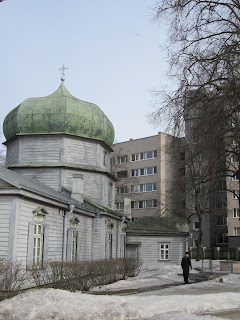Visited April 20, 2013
Today I mixed a little witchcraft with my church visits.
Okay, not really. But my trip today wasn't actually to see St Charles’ Lutheran Church in Tuhala. The church was built in 1777 and is located about 30 minutes outside of Tallinn on the road to Tartu. I was lucky enough to find this one open today, and a nice little old lady inside greeted me and the other people who were out there today.
I was glad to be able to get inside, because the altar was beautiful!
I was one of several to stop by this lonely little church in the middle of nowhere today, but that is because the witches well was boiling.
Estonia says it has five seasons: Spring, Summer, Fall, Winter and Flooding. We are in the latter, the 5th season, where all the snow is melting and all the rivers and streams are flooded.
When that happens, a well practically across the street from the church, known as the "Witches’ Well", occassionally begins to "boil" over (the last time was spring of 2008). Local legend holds that the well boils over when the witches of Tuhala make a sauna below the ground and beat each other with birch branches, causing a commotion on the surface.
The real reason is that well is near the Tuhala River, a 26 km long branch of the Pirita River. Some 6 km of its length runs underground. Water starts to spout up from the well and flood the area when excess water from the Mahtra swamp fills up the underground river and the overflowing river water seeks an escape through the well. The quantity of water flowing through the Tuhala River must be at least 5000 liters per second in order for the river to overflow, which only happens during the early part of the thaw.
Of course, it is possible that the thaw that causes the boiling is the result of the heat from the underground witches' sauna...
Today I mixed a little witchcraft with my church visits.
Okay, not really. But my trip today wasn't actually to see St Charles’ Lutheran Church in Tuhala. The church was built in 1777 and is located about 30 minutes outside of Tallinn on the road to Tartu. I was lucky enough to find this one open today, and a nice little old lady inside greeted me and the other people who were out there today.
I was glad to be able to get inside, because the altar was beautiful!
I was one of several to stop by this lonely little church in the middle of nowhere today, but that is because the witches well was boiling.
Estonia says it has five seasons: Spring, Summer, Fall, Winter and Flooding. We are in the latter, the 5th season, where all the snow is melting and all the rivers and streams are flooded.
When that happens, a well practically across the street from the church, known as the "Witches’ Well", occassionally begins to "boil" over (the last time was spring of 2008). Local legend holds that the well boils over when the witches of Tuhala make a sauna below the ground and beat each other with birch branches, causing a commotion on the surface.
The real reason is that well is near the Tuhala River, a 26 km long branch of the Pirita River. Some 6 km of its length runs underground. Water starts to spout up from the well and flood the area when excess water from the Mahtra swamp fills up the underground river and the overflowing river water seeks an escape through the well. The quantity of water flowing through the Tuhala River must be at least 5000 liters per second in order for the river to overflow, which only happens during the early part of the thaw.
Of course, it is possible that the thaw that causes the boiling is the result of the heat from the underground witches' sauna...

































